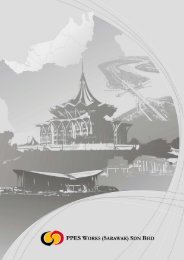Notes to the Financial Statements - Cahaya Mata Sarawak Bhd
Notes to the Financial Statements - Cahaya Mata Sarawak Bhd
Notes to the Financial Statements - Cahaya Mata Sarawak Bhd
You also want an ePaper? Increase the reach of your titles
YUMPU automatically turns print PDFs into web optimized ePapers that Google loves.
<strong>Notes</strong> <strong>to</strong> <strong>the</strong> <strong>Financial</strong> <strong>Statements</strong><br />
For <strong>the</strong> fi nancial year ended 31 December 2011<br />
2. Summary of signifi cant accounting policies (contd.)<br />
2.19 Impairment of fi nancial assets (contd.)<br />
(b) Unquoted equity securities carried at cost classifi ed as available-for-sale fi nancial assets<br />
If <strong>the</strong>re is objective evidence (such as signifi cant adverse changes in <strong>the</strong> business environment<br />
where <strong>the</strong> issuer operates, probability of insolvency or signifi cant fi nancial diffi culties of <strong>the</strong> issuer)<br />
that an impairment loss on fi nancial assets carried at cost has been incurred, <strong>the</strong> amount of <strong>the</strong><br />
loss is measured as <strong>the</strong> difference between <strong>the</strong> asset’s carrying amount and <strong>the</strong> present value of<br />
estimated future cash fl ows discounted at <strong>the</strong> current market rate of return for a similar fi nancial<br />
asset. Such impairment losses are not reversed in subsequent periods.<br />
2.20 Cash and cash equivalents<br />
Cash and cash equivalents comprise cash at bank and on hand, demand deposits, and short-term, highly<br />
liquid investments that are readily convertible <strong>to</strong> known amounts of cash and which are subject <strong>to</strong> an<br />
insignifi cant risk of changes in value. These also include bank overdrafts that form an integral part of <strong>the</strong><br />
Group’s cash management.<br />
2.21 <strong>Financial</strong> liabilities<br />
<strong>Financial</strong> liabilities are classifi ed according <strong>to</strong> <strong>the</strong> substance of <strong>the</strong> contractual arrangements entered in<strong>to</strong><br />
and <strong>the</strong> defi nitions of a fi nancial liability.<br />
<strong>Financial</strong> liabilities, within <strong>the</strong> scope of FRS 139, are recognised in <strong>the</strong> statement of fi nancial position when,<br />
and only when, <strong>the</strong> Group and <strong>the</strong> Company become a party <strong>to</strong> <strong>the</strong> contractual provisions of <strong>the</strong> fi nancial<br />
instrument. <strong>Financial</strong> liabilities are classifi ed as o<strong>the</strong>r fi nancial liabilities.<br />
O<strong>the</strong>r fi nancial liabilities<br />
The Group’s and <strong>the</strong> Company’s fi nancial liabilities include trade payables, o<strong>the</strong>r payables, loans and<br />
borrowings and income securities.<br />
Trade and o<strong>the</strong>r payables are recognised initially at fair value plus directly attributable transaction costs<br />
and subsequently measured at amortised cost using <strong>the</strong> effective interest method.<br />
Loans and borrowings are recognised initially at fair value, net of transaction costs incurred, and<br />
subsequently measured at amortised cost using <strong>the</strong> effective interest method. Borrowings are classifi ed as<br />
current liabilities unless <strong>the</strong> Group has an unconditional right <strong>to</strong> defer settlement of <strong>the</strong> liability for at least<br />
12 months after <strong>the</strong> reporting date.<br />
The Income Securities, which are recognised as fi nancial liabilities are measured initially at its fair value,<br />
which is <strong>the</strong> amount of proceeds received. In subsequent periods, <strong>the</strong> Income Securities are measured at<br />
amortised cost using <strong>the</strong> effective interest rate method. The amortised cost of <strong>the</strong> Income Securities is <strong>the</strong><br />
amount at which <strong>the</strong> Income Securities are measured at initial recognition minus <strong>the</strong> principal repayments,<br />
plus or minus <strong>the</strong> cumulative amortisation using <strong>the</strong> effective interest rate of any difference between <strong>the</strong><br />
initial amount and <strong>the</strong> maturity amount. The effective interest rate is <strong>the</strong> rate that exactly discounts estimated<br />
future cash payments through <strong>the</strong> expected life of <strong>the</strong> Income Securities. When calculating <strong>the</strong> effective<br />
interest rate, <strong>the</strong> Group has estimated cash fl ows considering all contractual terms of <strong>the</strong> Income Securities.<br />
The amortised expense of <strong>the</strong> Income Securities, applying <strong>the</strong> effective interest rate, is recognised in profi t<br />
or loss as fi nance costs in <strong>the</strong> period in which it is incurred.<br />
Annual Report 2011 95







